Transcript
Lance Humphrey: [00:13] When typically evaluating managers, we've all heard the four P’s, People, Process, Philosophy, and Performance, but when we're looking at rules-based strategies, I think it's important to take a different lens and look at some of the other underlying drivers of performance. The way I remember that is the five Cs which is Combination, Concentration, Construction, Constraints and Craftsmanship. And just real quick, it's things like if we're using multiple factors in a portfolio how do we combine them? Do we put them together as separate portfolios or do we look for stocks that share characteristics of both? From a construction standpoint, how are we weighting the portfolio? Is it capitalization weighted? Is it equal weighted or is it alternatively weighted? Those types of decisions make a very important impact on the overall outcome investors could expect.
Lance Humphrey: [00:56] Well, if you think about it in 2018, let's take the momentum factor for example. Whereby the textbook academic version, the momentum factor, outperformed the market last year. However, if we look at the 18 different ETFs that track the US large cap market that focus on momentum more than 14 of them underperformed the market. Well, why is that? A lot of it happens to be because of the different considerations we just mentioned. Some of them use a more equal weighted scheme or some might use a weight times score type scheme. Those types of things can have a very big impact on a factor that may have outperformed, but then the way that it's implemented leads to varying outcomes.
Lance Humphrey: [01:32] Well, we've used factors in our portfolios for many years, and when we thought about what we wanted to deliver to our members and to our advisors, was really the factors that we wanted to have in our portfolios at all times, what I call the Varsity Team factors. We think that value and momentum are two factors that combine together very well from a correlation perspective and they're two factors that we want to have in our portfolio across all market environments. Other factors like quality or volatility or size we use, but we really wanted to focus on the two that we believe deserve to be a core part of many investors’ portfolio.
Lance Humphrey: [02:03] Well, I think it's really important to focus on diversification. A lot of times we do get wrapped up in what factor are we targeting or how do we define the factor when the underlying weighting scheme really can drive a really large portion of returns. And again, we chose to focus on a risk-weighting scheme which essentially takes the stocks and the portfolio and allows them to equally contribute to the risk of the overall portfolio meaning we don't want one stock like say Apple to be driving the performance of the return at the expense of some of the smaller stocks. We really wanted to take an approach that allowed us to target a positive basket of securities but then be very diversified and balanced in the way we weight them.
Lance Humphrey: [02:40] I think it's just again important to really understand what those considerations are within the portfolio and in addition to just understanding what they are, understanding how they might impact the performance outcomes over time.





